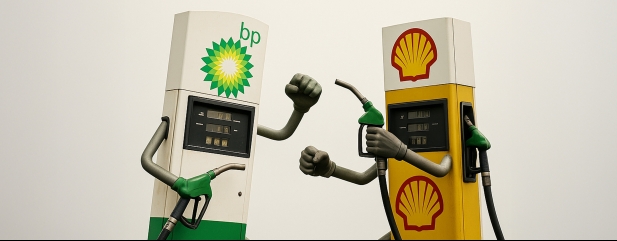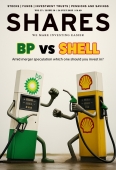Archived article
Please note that tax, investment, pension and ISA rules can change and the information and any views contained in this article may now be inaccurate.
BP vs Shell

The divergence in fortunes between Shell (SHEL) and BP (BP.) in recent times has been striking and arguably reached its apotheosis with reports in June 2025 the former was set to make a bid for the latter.
Shell has consistently poured cold water on this speculation but, if nothing else, the fact a rumour which has done the rounds multiple times over the years actually had a ring of credibility on this occasion reflects the relative standings of the two businesses.
This article aims to unpick how we got here and how the investment cases for both businesses stack up today.
BP AND SHELL 101
Both companies are global integrated energy firms which means they operate worldwide across the entire oil and gas ecosystem from upstream (exploration and production) to downstream (refining, marketing and distribution to end-users) and midstream (transportation and storage). They also have modest investments in clean energy. BP employed more than 100,000 people in 2024, while Shell’s headcount is above 90,000. Shell is the third largest company and BP the ninth largest company in the FTSE 100 by market valuation.
SHELL’S ADVANTAGE A DECADE IN THE MAKING
In our view, Shell’s stronger position is more than a decade in the making. Looking at the relative performance of their shares over the last 20 years, it is evident that, after briefly outperforming in the mid-noughties, BP has not kept pace ever since the Deepwater Horizon disaster and resulting oil spill in the Gulf of Mexico in April 2010.
That crisis and its fall-out consumed a significant amount of the company’s resources and management time which could have been directed towards developing a long-term strategy for the business.
The company finally agreed a $20.7 billion fine – the largest environmental damage settlement in US history – in April 2016, and also paid out billions of dollars in damages to affected individuals and businesses while incurring hefty clean-up costs.
BP is still paying off the fine agreed nearly 10 years ago, with payments set to be made up until 2034 under the terms of said agreement.
Its market valuation, which at one point before the disaster was higher than Shell, is now just 40% of that of its domestic rival, though whether this genuinely makes it an easier-to-swallow target is a subject we will return to later.
In more recent years, BP has been dogged by issues with management – CEO Bernard Looney leaving under a cloud after failing to disclose personal relationships with colleagues – and a poorly-received and subsequently abandoned energy transition strategy.
What is recent trading like at BP and Shell
Looked at through the lens of their most recent comments on trading BP is actually outshining Shell.
On 11 July, in its usual teaser ahead of quarterly results, BP stated it expected second-quarter upstream output to be higher than in the first three months of 2025. The Customers & Products segment is projected to benefit from increased refining margins, estimated between $300 million and $500 million, alongside a higher level of turnaround activity. The oil trading result is also anticipated to remain strong.
However, BP’s second-quarter results are likely to reflect the impact of lower oil and gas prices, following a decrease in crude prices attributed to OPEC+ countries unwinding self-imposed production cuts in April. According to the company, average crude prices were $67.77 per barrel in the second quarter, compared to $75.73 in the first quarter.
Shell issued an updated outlook for its Integrated Gas unit production in its own pre-results announcement on 7 July. The company forecast output of 900,000 to 940,000 barrels of oil equivalent per day (boepd) in Integrated Gas, relative to the previous range of 890,000-950,000 boepd reported in its first-quarter results. Expected LNG volumes are now 6.4 million to 6.8 million metric tonnes, with the upper end reduced from 6.9 million and the lower end raised from 6.3 million.
Shell indicated second-quarter trading and optimisation results in Integrated Gas and Chemicals & Products would be significantly lower than those posted in the first quarter. For Upstream, Shell’s second-quarter output forecast is 1.66 million to 1.76 million boepd, with the lower end revised upward from the previously stated 1.56 million in the first-quarter outlook.
NEITHER PERFORMING NOR TRANSFORMING
When first announced in February 2020, the ‘performing while transforming’ plan revealed ambitious goals around reducing the firm’s reliance on oil and gas production and shifting into renewables.
The problem was that said oil and gas production generated most of the cash flow which paid the bills and, crucially, facilitated returns to shareholders.
The pandemic obviously did not help as energy prices crashed, with both BP and Shell using this as an opportunity to reset their dividends (Shell cutting its payout for the first time since the Second World War), but what really shifted the calculus was the invasion of Ukraine by Russia in early 2022. As well as boosting energy prices, it also pushed the focus from the energy transition to energy security.
Both BP and Shell, which had its own transition strategy, subsequently dialed back on their green push. The former has been under particular pressure to do so from activist investor Elliott since it joined the shareholder register at the beginning of 2025.
Current BP chief executive Murray Auchincloss unveiled a renewed focus on hydrocarbons at an investor day in February, but most parties, including Elliott, seemed to feel what had been announced did not go far enough.
The departure of chair Helge Lund, who is set to be replaced by former CRH (CRH:NYSE) CEO Albert Manifold, reflects the perception he is a key architect of BP’s recent problems.
One of the concrete measures unveiled by the company was a series of disposals – including the Castrol lubricants business – but the suggestion is Auchincloss and his team are struggling to achieve the price tags they are looking for from potential suitors.
It doesn’t help that BP’s problems, including a stretched balance sheet, are well known, which puts it in a less-than-ideal negotiating position.
The company at least made some progress on this front in July 2025 when it divested its US onshore wind business for an undisclosed sum.
MOVING FURTHER AND FASTER
Shell has moved further and faster under CEO Wael Sawan, who took the helm in January 2023 having served time in the company’s gas operations.
Sawan has adopted a hard-nosed attitude as he looks for Shell to play catch up with US peers, with any investments in green energy having to pay their way, and Shell has outperformed the S&P 500 Energy sector over the course of Sawan’s tenure.
That is not to say it has always been smooth sailing for Shell either but, free from the sort of legacy created by the Macondo disaster and with a more stable management in place, the company has had a more coherent long-term strategy.
Much of this has centred around natural gas which appears to have a role to play as countries slowly wean themselves off more polluting fuels like coal and oil.
The £36 billion acquisition of BG, which completed in 2016, substantially bolstered Shell’s footprint in LNG (liquefied natural gas). In 2024 the company’s Integrated Gas division, which incorporates LNG, accounted for more than 50% of its earnings.
It is also a key driver of cash flow for the group and, while returns are heavily tied to oil price linked contracts, the scale of the business means it can operate profitably against most market backdrops.
WHY SHELL IS A BETTER INVESTMENT THAN BP
Despite BP’s bombed-out share price, with the stock trading at its lowest level in more than three years, we would regard Shell as a much more attractive investment – on the important condition it does not take the plunge and actually pursue a deal with BP.
One big sticking point we would have with any merger is the borrowings Shell would have to absorb.
Berenberg analyst Henry Tarr observes: ‘BP is significantly more geared than Shell, with gross debt at end-2024 of $71 billion including leases, and $88 billion including hybrids, and this leverage eats into free cash flow generation.’
Tarr adds: ‘While we can see a path to significant cost savings and synergies on paper, in practice such a merger is always complicated. The culture of the two organisations has historically been quite different, which could prove challenging in achieving the synergies quickly.
‘A deal of this size would inevitably be the defining moment for Shell’s management team, which are only two years into shaping Shell into a more competitive business.’
AVOIDING A POTENTIALLY MESSY DEAL
This is a key point for us, Shell should stick to its knitting and Sawan should not budge from his stance that the best use of excess capital is buying back the company’s own shares.
Assuming it does so, then Shell could represent a useful addition to portfolios, as long as investors are comfortable with the inherent volatility in the company’s business, the longer-term risks around the energy transition and any ethical qualms about the company’s impact on the environment.
On valuation grounds, while Shell has a slightly lower dividend yield than BP, 4.5% versus 5.4%, it actually trades on a lower earnings multiple. Catalysts for the share price include new upstream developments in Latin America and further LNG projects which should help to grow free cash flow growth and thereby underpin returns to shareholders.
Important information:
These articles are provided by Shares magazine which is published by AJ Bell Media, a part of AJ Bell. Shares is not written by AJ Bell.
Shares is provided for your general information and use and is not a personal recommendation to invest. It is not intended to be relied upon by you in making or not making any investment decisions. The investments referred to in these articles will not be suitable for all investors. If in doubt please seek appropriate independent financial advice.
Investors acting on the information in these articles do so at their own risk and AJ Bell Media and its staff do not accept liability for losses suffered by investors as a result of their investment decisions.
 magazine
magazine








